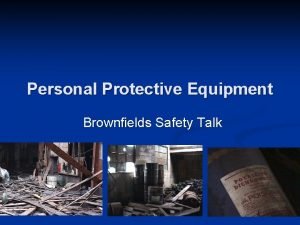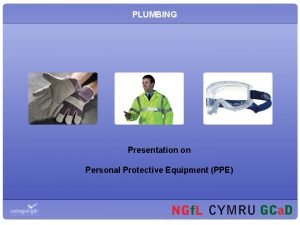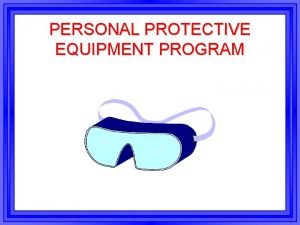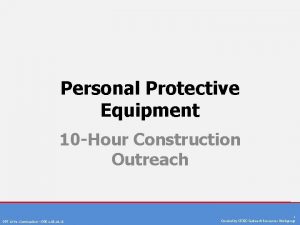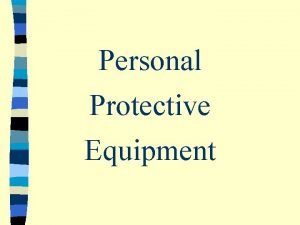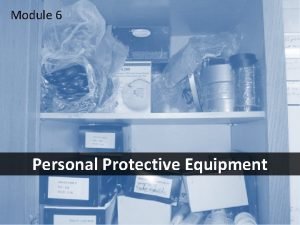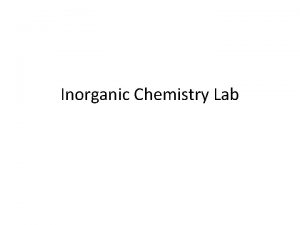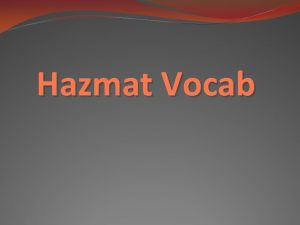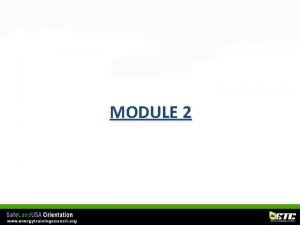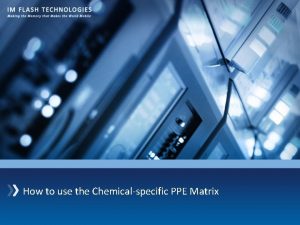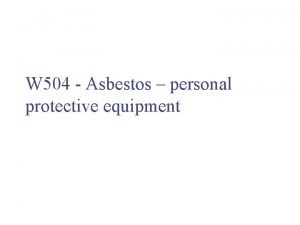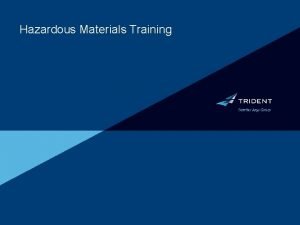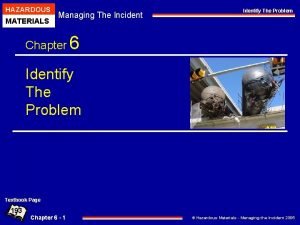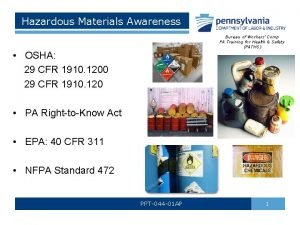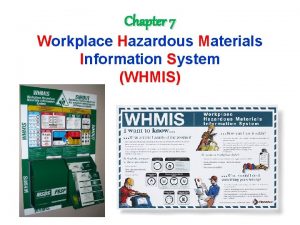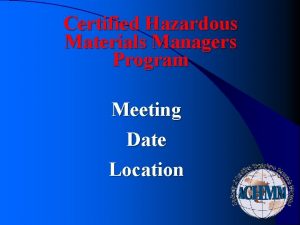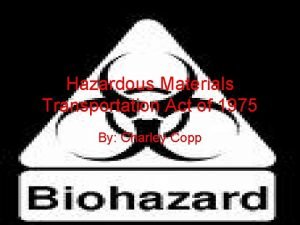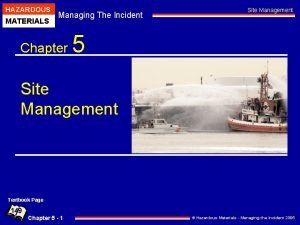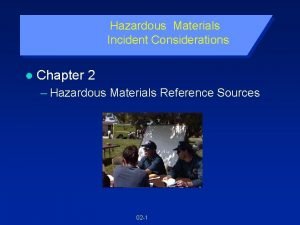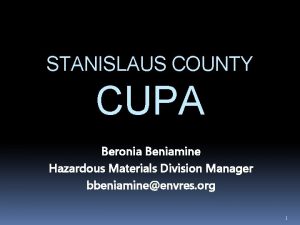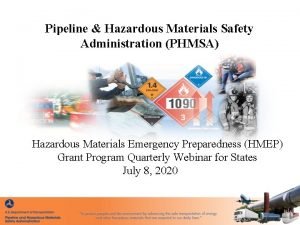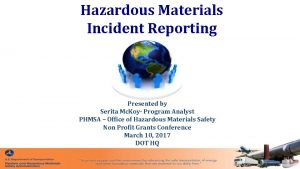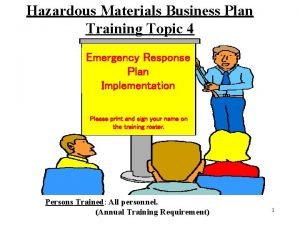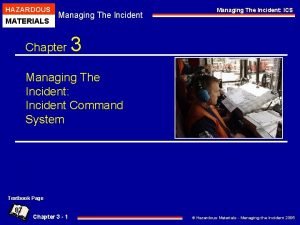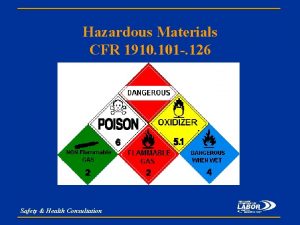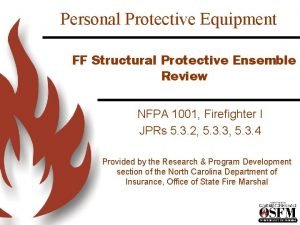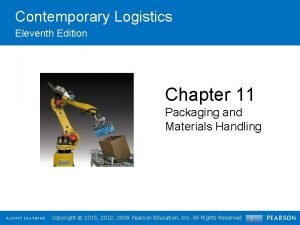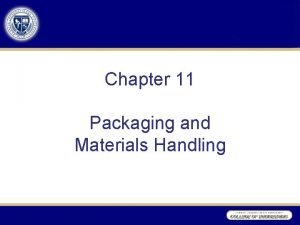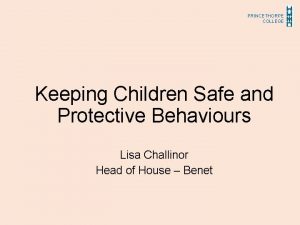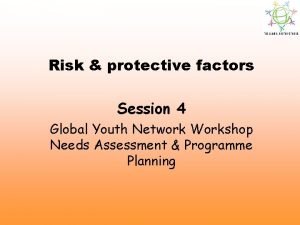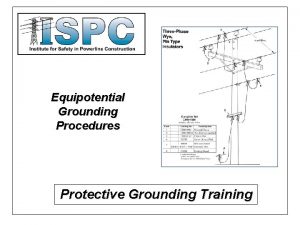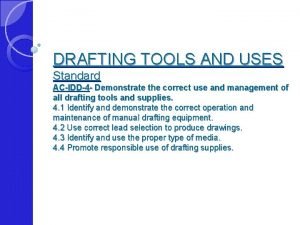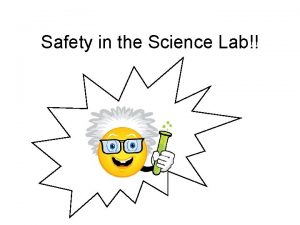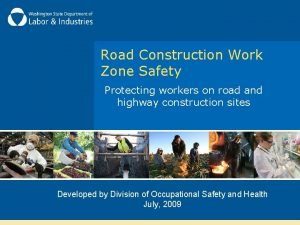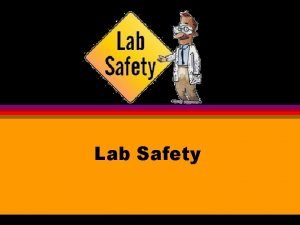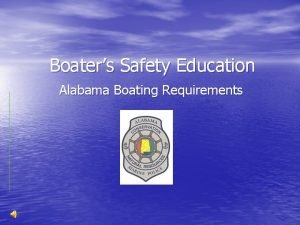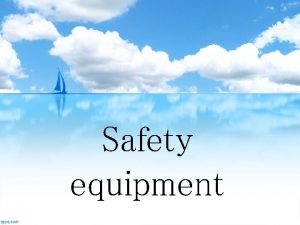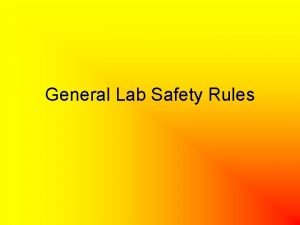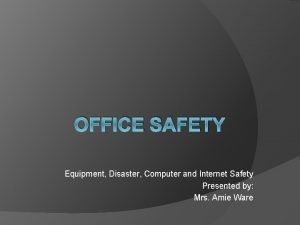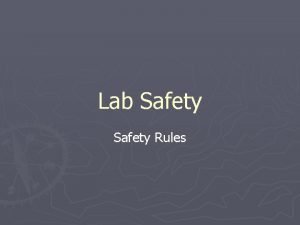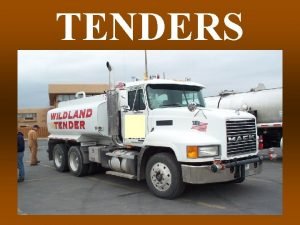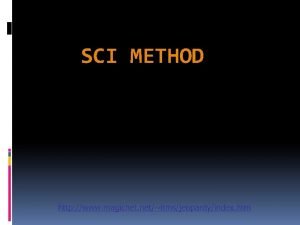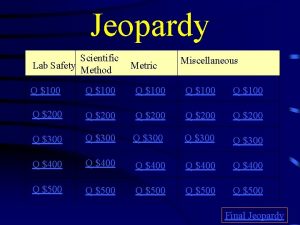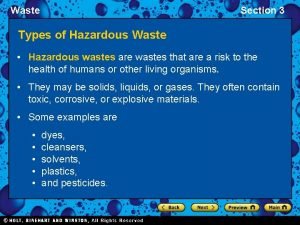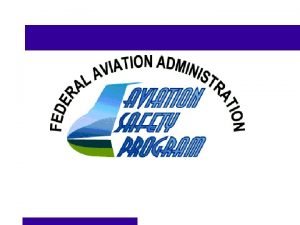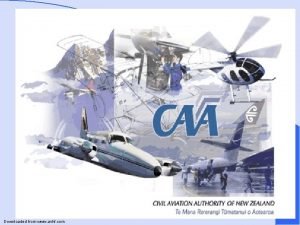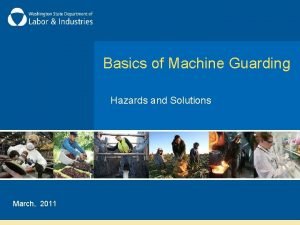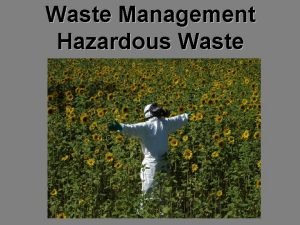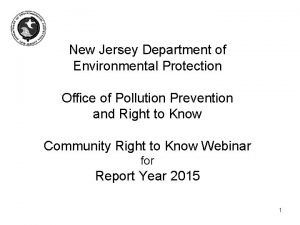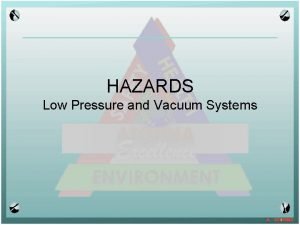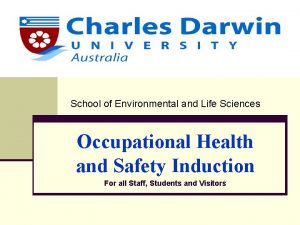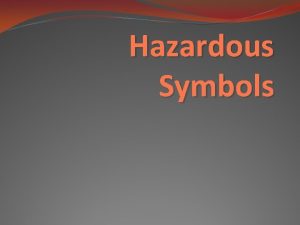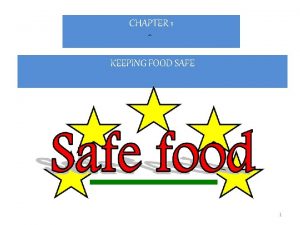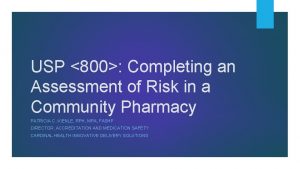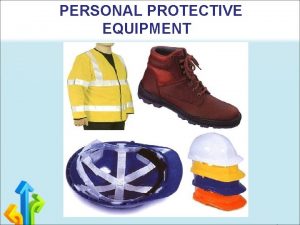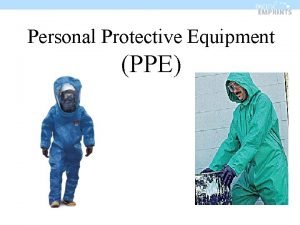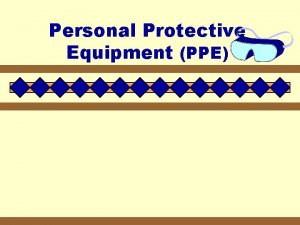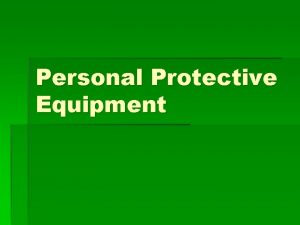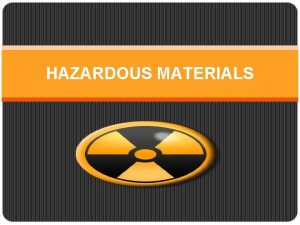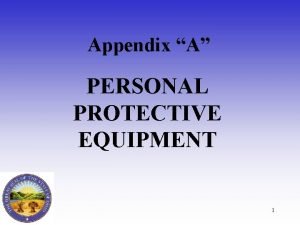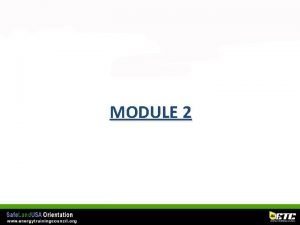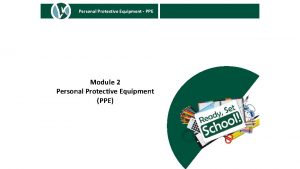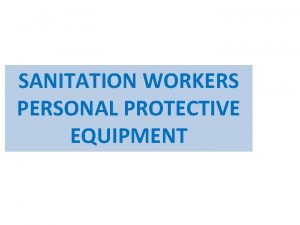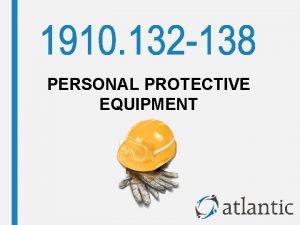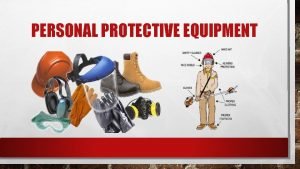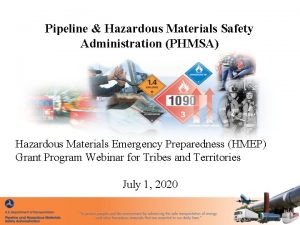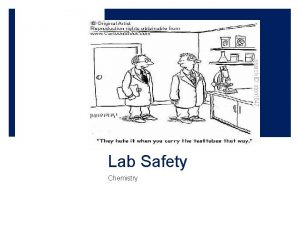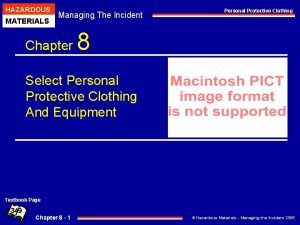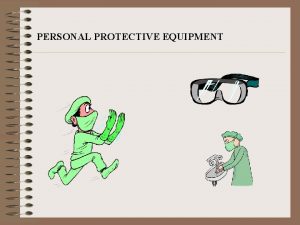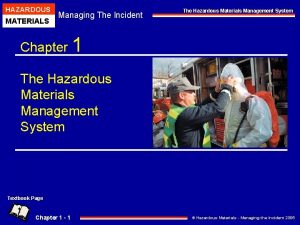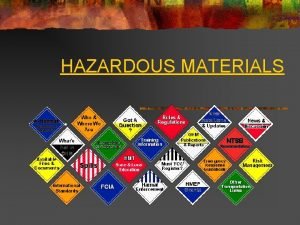31 Hazardous Materials Personal Protective Equipment Scene Safety









































































- Slides: 73

31 Hazardous Materials: Personal Protective Equipment, Scene Safety, and Scene Control

31 Objectives (1 of 5) • Describe personal protective equipment (PPE) used for hazardous materials incidents.

31 Objectives (2 of 5) • Identify the purpose, advantages, and limitations of the following items: – Structural firefighting protective clothing – High-temperature-protective clothing – Chemical-protective clothing – Liquid splash-protective clothing – Vapor-protective clothing.

31 Objectives (3 of 5) • Discuss respiratory protection in a hazardous material incident. • Describe the levels of hazardous materials personal protective equipment.

31 Objectives (4 of 5) • Identify skin-contact hazards encountered at hazardous materials incidents. • Describe the safety precautions to be observed, including those for heat and cold stress, when approaching and working at hazardous materials incidents.

31 Objectives (5 of 5) • Describe the physical capabilities required and limitations of personnel working in PPE. • Describe techniques used to isolate hazard areas and deny entry. • Describe the importance of the buddy system and backup personnel.

31 Introduction • At a hazardous materials incident, PPE, scene control, site management, and personal accountability are critical issues. • Safe handling of hazardous materials incident is often determined in the first 5 to 15 minutes

31 Levels of Damage • • • TLV-STEL TLV-TWA TLV-C Threshold limit value/skin PEL IDLH

31 Threshold Limit Value • The point at which the material begins to affect a person • Various definitions indicate the levels of protection that are required

31 TLV-STEL • Maximum concentration a person can be exposed to in 15 -minute intervals, up to four times a day without damage. • Minimum 1 hour rest between exposures • Lower the TLV-STEL, the more toxic the substance.

31 TLV-TWA • Maximum concentration a person can be exposed to 8 hours a day, 40 hours a week without damage • The lower the TLV-TWA, the more toxic the substance.

31 TLV-C • Maximum concentration a person can be exposed to, even for an instant. • The lower the TLV-C, the more toxic the substance.

31 Threshold Limit Value/Skin • Indicates the concentration at which direct exposure or airborne contact with a material could result in possible and significant exposure by absorption through the skin, mucous membranes, and eyes. • Take appropriate measures to minimize contact with the skin.

31 PEL • Also called the Recommended Exposure Level (REL) • Comparable to the TLV-TWA • Maximum, time-weighted concentration to which 95% of healthy adults can be exposed over a 40 -hour workweek without damage

31 IDLH (1 of 2) • An atmospheric concentration of any toxic, corrosive, or asphyxiant that poses an immediate threat to life or could cause irreversible or delayed adverse health effects

31 IDLH (2 of 2) • Three types of IDLH atmospheres: – Toxic – Flammable – Oxygen deficient • IDLH atmospheres require the use of SCBA or equivalent protection.

31 Determining Atmospheric Safety • Atmospheric monitoring requires specific training and equipment. • Three types of atmospheres at a hazardous materials incident: – Safe – Unsafe – Dangerous

31 Selection of Proper PPE • Potentially life-saving decision • The IC should approve the level of PPE to be used on an incident. • Fire fighters should not use PPE they have not been trained to use.

31 Types of PPE • • Street clothing and work uniforms Structural firefighting protective clothing High-temperature-protective clothing Chemical-protective clothing and equipment

31 Hazardous Materials Protection (1 of 2) • Street clothing and work uniforms – Offers no protection from hazardous materials • Structural firefighting protective clothing – Offers almost no chemical protection

31 Hazardous Materials Protection (2 of 2) • High-temperatureprotective clothing – Offers protection from high temperatures only

31 Chemical Protective Clothing and Equipment • Designed to prevent chemicals from coming in contact with the body – Have varying degrees of resistance • Chemical-resistant materials – Designed to inhibit or resist the passage of chemicals into and through the material by penetration, permeation, degradation.

31 Penetration • Flow or movement of a hazardous chemical through closures, seams, porous materials, pinholes, or other imperfections • Liquids and solids can penetrate.

31 Permeation • Process by which a hazardous chemical moves through a material at the molecular level • Occurs through the material itself, rather than through an opening in the material

31 Degradation • Physical destruction or decomposition of a material due to chemical exposure, general use, or ambient conditions • Usually evidenced by signs such as charring, shrinking, swelling, color changes, or dissolving

31 Garment Construction • Single piece – Completely encloses wearer – Known as an encapsulated suit or acid suit • Multipiece – Works with the wearer’s respiratory protection, an attached or detachable hood, gloves, and boots

31 Material Used In Construction • • • Butyl rubber Tyvek® Saranex PVC Vitron

31 Liquid Splash-Protective Clothing • Protects skin and eyes • Does not provide total body protection from gases or vapors

31 Vapor-Protective Clothing • Must be used when hazardous vapors are present • Traps heat and perspiration • SCBA or air-line hoses must be used

31 Respiratory Protection Devices • Self-contained breathing apparatus (SCBA) • Supplied air respirator (SAR) • Air-purifying respirator (APR)

31 SCBA • Prevents exposure through inhalation or ingestion • Should be mandatory for fire service personnel • Fire fighters must know the limitations of SCBA

31 SAR • A hose connects the user to the air source and provides air to the face piece. • Useful during extended operations • Length of hose line may restrict movement.

31 APRs • Removes particulates and contaminants from the air • Should only be used when: – Type and amount of contaminants known – Atmosphere is not oxygen deficient. (1 of 2)

31 APRs (2 of 2) • Do not have a separate source of air • Ambient atmosphere must contain a minimum of 19. 5% oxygen. • Filtering cartridges are contaminant specific. • Atmosphere must be continuously monitored.

31 Level A Protection • Heavy encapsulating suit – Highest level of protection – Effective against vapors, gases, mists, dusts • Requires SCBA or SAR

31 Level B Protection • Chemical-protective clothing, boots, gloves, and SCBA • High respiratory protection but less skin protection required

31 Level C Protection • Standard work clothing plus chemical -protective clothing, chemical-resistant gloves, and a form of respiratory protection

31 Level D Protection • Lowest level of protection • Should be used for nuisance contamination only

31 Skin Contact Hazards (1 of 4) • Principal dangers of hazardous materials are toxicity, flammability, and reactivity. • Hazardous materials can harm the inadequately protected body. • Assume the worst, and leave the largest possible safety margin.

31 Skin Contact Hazards (2 of 4) • Skin can absorb harmful toxins without any sensation to the skin itself. – Do not rely on pain or irritation as a warning of absorption. – Some substances are lethal if only a few drops contact the skin.

31 Skin Contact Hazards (3 of 4) • Skin absorption is enhanced by abrasions, cuts, heat, and moisture. • Absorption rate depends on body part. – Chemicals are absorbed through the skin on the scalp much faster than through the forearm. – Eyes have one of the fastest means of exposure.

31 Skin Contact Hazards (4 of 4) • Corrosives will immediately damage skin or body tissues upon contact. – Acids • Have a strong affinity for moisture • Create a clot-like barrier that blocks deep skin penetration – Alkalis • Turns tissue to soapy liquid

31 Safety Precautions • Standard safety precautions for firefighting apply to hazardous materials incidents. • In addition, special attention must be paid to temperature and stress.

31 Excessive Heat Disorders • Fire fighters operating in protective clothing should be aware of the signs and symptoms of heat exhaustion, heat stress, heat stroke and dehydration.

31 Heat Exhaustion (1 of 2) • Mild form of shock caused by overheating when the body cannot dissipate heat • Body’s core temperature rises causing weakness and profuse sweating followed by dizziness or blurred vision

31 Heat Exhaustion • Emergency action: – Remove victim from the source of heat. – Rehydrate – Provide cooling (2 of 2)

31 Heat Stroke (1 of 2) • Life-threatening condition resulting from the total failure of the body’s temperatureregulation capacity • Signs and symptoms include: – Reduction or cessation of sweating – Body temperature at or above 105 ºF – Rapid pulse

31 Heat Stroke (2 of 2) • Signs and symptoms (continued) – Hot skin – Headache – Confusion – Unconsciousness • This is a true medical emergency requiring immediate transport to a medical facility.

31 Dehydration • Prehydrate with 8 to 16 oz. of water before donning PPE. • Rehydrate with 16 oz. of water for each SCBA tank used.

31 Cooling Technologies (1 of 3) • Many response agencies employ some form of cooling technology under the garment – Air, ice, and water cooled vests – Phase change cooling technology – Each is designed to reduce the impact of heat stress on the body

31 Cooling Technologies (2 of 3) • Forced air-cooling systems – Operate by forcing pre-chilled air through a system of hoses worn close to the body. • Fluid-chilled systems – Operate by pumping ice-chilled liquids from a reservoir through a series of tubes held within a vest-like garment.

31 Cooling Technologies (3 of 3) • Passive systems (ice or gel packed vests) – Commonly used due to low cost – Designed to be worn around the torso • Phase change cooling technology – Similar to passive systems – Chilled to 60 °F – Fabric of the vest is designed to wick perspiration away from the body.

31 Cold-Temperature Exposures (1 of 3) • Two types of cold exposure: – Materials related • Liquefied gases and cryogenic materials expose fire fighters to the same low-temperature hazards as those created by cold-weather environments – Weather related • Temperature and wind speed • Still air is a poor conductor

31 Cold-Temperature Exposures (2 of 3) • Despite temperature, fire fighters will sweat. – Wet clothing extracts heat from the body up to 240 times faster than dry clothing. – May lead to hypothermia

31 Cold-Temperature Exposures (3 of 3) • Prevention – Wear appropriate, layered clothing. – Keep layers next to skin dry. – Warm shelters should be available.

31 Physical Capability Requirements • Hazardous materials response operations put a great deal of both physiological and psychological stress on responders. • Every emergency response organization should have a health and safety management program.

31 Medical Surveillance Program (1 of 2) • Cornerstone of the health and safety management system • Two primary objectives: – Determine fitness for duty – Detect changes in body system functions

31 Medical Surveillance Program (2 of 2) • Ongoing, systematic evaluation of response personnel • Fire fighters should be examined by a physician at least once a year.

31 Medical Monitoring (1 of 3) • Pre-entry – Vital signs – Skin inspection (rashes or open sores) – Should be completed within the hour before the fire fighter enters the hazardous environment

31 Medical Monitoring (2 of 3) • During the incident – Team member exhibits changes in gait, speech, or behavior – Anyone complaining of chest pain, dizziness, shortness of breath, weakness, nausea, or headache

31 Medical Monitoring (3 of 3) • After decontamination – Normal baseline values should be attained within 15 to 20 minutes – Anyone who does not return to baseline levels should be treated and transported to a definitive care facility – Vital signs should be checked every 5 to 10 minutes

31 Response Safety Procedures • Isolate and deny entry. • Eliminate ignition sources. • Operations cannot begin until the area is identified and the perimeter is secured

31 Control Zones (1 of 2) • Designated areas at a hazardous materials incident based upon safety and the degree of hazard • Labels: – Hot zone – Warm zone – Cold zone

31 Control Zones (2 of 2)

31 Hot Zone • Area immediately around the incident site • Contains personnel and equipment needed to control the release • Access is limited. • Entries and exits are logged. • Technicians only

31 Warm Zone • Staging area for entering and leaving the hot zone • Contains an access corridor and a decontamination corridor • Only essential personnel allowed. • Generally one level below what is used in the hot zone

31 Cold Zone • “Safe area” where special protective clothing is not needed • Cold zone operations include: – Personnel staging – Incident Command Post – EMS providers – Area for medical treatment

31 Isolation Techniques (1 of 2) • Approach from upwind and uphill. – Resist the urge to rush in. – Keep people away from the scene and outside the safety perimeter. – Identify the area verbally over the radio – Cordon off the area – Police officers should assist fire fighters

31 Isolation Techniques (2 of 2)

31 Buddy System and Backup Personnel • Backup personnel are used to ensure the safety of emergency crews. • The decontamination team must be in place before anyone enters the hot zone. • No one should enter the hot zone alone. • Team members should always remain within sight, sound, or touch of each other.

31 Summary (1 of 3) • PPE must be chosen specifically for the hazardous materials involved in an incident. • Four recognized levels of protective clothing • Use of respiratory protection is essential on most hazardous materials incidents.

31 Summary (2 of 3) • Be aware of and know how to handle both heat- and cold-related emergencies. • Monitor responder vital signs before, during, and after a hazardous materials incident. • Resist the urge to rush in.

31 Summary (3 of 3) • Only fire fighters trained to the technician or specialist levels should enter the hot zone. • Work in teams of two in the hot zone. • Ensure a backup team is prepared to enter the hot zone to effect a rescue.
 Personal protective equipment safety talk
Personal protective equipment safety talk Ppe in plumbing
Ppe in plumbing Program
Program Protective equipment in sports ppt
Protective equipment in sports ppt Electrode stubs should be placed
Electrode stubs should be placed Objectives of ppe
Objectives of ppe Personal protective equipment for farmers
Personal protective equipment for farmers A worker mixing chemicals must not wear
A worker mixing chemicals must not wear Ignorganic chemical equipment
Ignorganic chemical equipment Personal protective equipment vocabulary
Personal protective equipment vocabulary Summary of personal protective equipment
Summary of personal protective equipment Personal protective equipment pictograms
Personal protective equipment pictograms Chemical ppe matrix
Chemical ppe matrix Asbestos personal protective equipment
Asbestos personal protective equipment Ppe in plumbing
Ppe in plumbing Contact precautions ppe
Contact precautions ppe What is hazardous material
What is hazardous material Hazardous materials table
Hazardous materials table Us military marking system for hazardous materials
Us military marking system for hazardous materials Hazwoper
Hazwoper Workplace hazardous materials information system symbols
Workplace hazardous materials information system symbols Isachmm
Isachmm Hazardous materials transportation act of 1975
Hazardous materials transportation act of 1975 Hazardous materials managing the incident
Hazardous materials managing the incident Hazardous materials reference books
Hazardous materials reference books Stanislaus county hazardous waste
Stanislaus county hazardous waste Pipeline and hazardous materials administration
Pipeline and hazardous materials administration Hazardous materials incident report
Hazardous materials incident report Hazardous materials business plan
Hazardous materials business plan Hazardous materials managing the incident
Hazardous materials managing the incident Osha 1910 psm
Osha 1910 psm Special protective equipment used in firefighting except
Special protective equipment used in firefighting except Protective packaging and materials handling
Protective packaging and materials handling Packing learning objectives
Packing learning objectives Personal safety vs process safety
Personal safety vs process safety Safety continuum protective behaviours
Safety continuum protective behaviours Personal protective factor
Personal protective factor Personal protective grounding
Personal protective grounding Drafting tools uses
Drafting tools uses Cant stop the feeling go noodle
Cant stop the feeling go noodle Harmful and useful materials
Harmful and useful materials Man made map
Man made map Adapting and adopting materials
Adapting and adopting materials Direct materials budget with multiple materials
Direct materials budget with multiple materials Science safety equipment
Science safety equipment Science safety equipment
Science safety equipment Heavy equipment safety poster
Heavy equipment safety poster Poem about momentum and impulse
Poem about momentum and impulse Safety symbols in lab
Safety symbols in lab Alabama boat requirements
Alabama boat requirements Slobo risancic
Slobo risancic Lab safety dress code
Lab safety dress code Computer safety equipment
Computer safety equipment Lab equipment and safety quiz
Lab equipment and safety quiz Heavy equipment inspection checklist
Heavy equipment inspection checklist Scientific method jeopardy
Scientific method jeopardy Mobile equipment safety policy
Mobile equipment safety policy Lab safety and equipment jeopardy
Lab safety and equipment jeopardy Macbeth summary act 1 scene 1
Macbeth summary act 1 scene 1 Macbeth plot
Macbeth plot Section 3 hazardous waste answers
Section 3 hazardous waste answers Aviation hazardous attitudes
Aviation hazardous attitudes Hospital waste management introduction
Hospital waste management introduction Five hazardous attitudes
Five hazardous attitudes 5 hazardous attitudes
5 hazardous attitudes Transverse motion machine
Transverse motion machine Hazardous waste apes
Hazardous waste apes Sample of hazardous waste
Sample of hazardous waste Nj crtk environmental hazardous substances
Nj crtk environmental hazardous substances Igcse
Igcse Hazardous area training darwin
Hazardous area training darwin Hazardous symbols
Hazardous symbols Potentially hazardous food is usually moist
Potentially hazardous food is usually moist Hazardous drug api
Hazardous drug api
